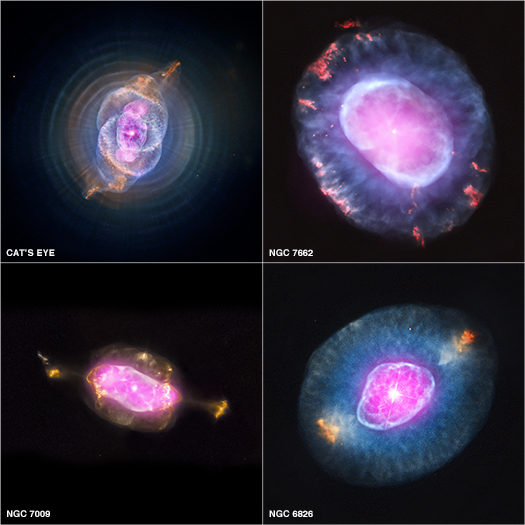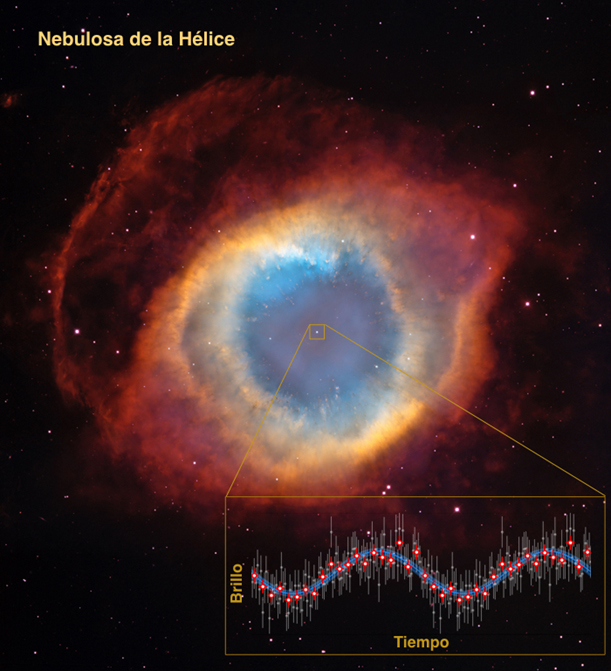A companion star: possible origin of the complex shapes of planetary nebulae
Data from the TESS space telescope show variability in a sample of planetary nebulae, compatible with the presence of a companion star. This binarity could explain the complex morphologies of these objects, which result from the death of low and intermediate mass stars
The Sun, with an approximate age of four thousand five hundred million years, is currently in the middle of its life. In another five billion years, its size will almost reach Mars' orbit, it will eject its outer layers and become a planetary nebula. Although around 99% of the stars in the universe will end their lives in this way, the origin of the beautiful morphologies that these objects present is still unknown. A new study reveals, thanks to data from the TESS space telescope, clear signs of variability in various planetary nebulae, compatible with the existence of a companion star that could explain the complexity of their shapes.

80% of the approximately three thousand planetary nebulae known in the Milky Way have complex morphologies, difficult to explain with the basic planetary formation model, which would give rise to spherical nebulae. Their shapes point to the existence of asymmetries during the star's mass loss process, perhaps due to its interaction with a companion star. However, this hypothesis does not yet have clear observational evidence since, to date, only about sixty binary stars have been detected in these objects.
In the present study, data from the TESS space telescope have been used to detect binary stars in the nuclei of several planetary nebulae. "Of the eight central stars of planetary nebulae analyzed, seven show clear signs of variability, compatible in most cases with the presence of a companion star. The eighth, which does not seem to have variability at least in the twenty-seven days in which the data has been taken, is the only apparently spherical planetary nebula in the sample, something that would confirm the theory of binariness", says Alba Aller Egea, researcher from the Center of Astrobiology (CAB, CSIC-INTA) that is leading the study.
The results obtained for the Helix nebula are especially interesting. "In this nebula, one of the most studied and also one of the closest to Earth (about 650 light years), a clear variability is detected for the first time, consistent with the presence of a companion low-mass star or a substellar object (such as a brown dwarf or a planet) –Alba Aller (CAB, CSIC-INTA) points out–. If binarity is confirmed, the 2.8 day period of the signal would be the time when both stars complete an orbit around the common center of mass".

Although designed primarily for the detection of terrestrial planets, TESS satellite allows access to data from many other types of objects. “In the case of planetary nebulae, TESS offers the possibility of studying in great detail and high precision the pulsation and rotation of central stars, and if they are part of a binary system. The latter is especially relevant to corroborate the ideas that suggest that the formation of complex planetary nebulae, as is the case of the Helix nebula, is linked to binary stars. In them, the companion would play a crucial role in the geometry of mass ejection in the evolutionary phase prior to that of the planetary nebula and, therefore, in the generation of nebulae with such complicated and varied shapes", says Luis F. Miranda, researcher at the Institute of Astrophysics of Andalusia (IAA-CSIC) who participates in the research.
A. Aller, J. Lillo-Box, D. Jones, L.F. Miranda, y S. Barceló Forteza. “Planetary nebulae seen with TESS: Discovery of new binary central star candidates from Cycle 1”. Astronomy & Astrophysics https://doi.org/10.1051/0004-6361/201937118
Instituto de Astrofísica de Andalucía (IAA-CSIC)
Unidad de Divulgación y Comunicación
Silbia López de Lacalle - sll[arroba]iaa.es - 958230676
https://www.iaa.csic.es
https://divulgacion.iaa.csic.es

